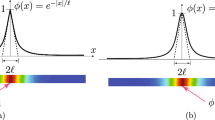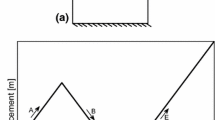Abstract
An adaptive multiscale modeling approach based on the multiscale discrete damage theory (MDDT) is established to describe formation of arbitrarily oriented and progressively reorienting cracks at multiple scales in heterogenous materials. MDDT tracks the fracture process over a set of discrete cohesive failure surfaces in the microstructure and consistently bridges the microscopic cracks to the continuum representation of damage at macroscale based on the reduced-order homogenization method. In this manuscript, the adaptation to arbitrary orientation of a crack is achieved using the idea of effective rotation of microstructure which reorients the prescribed failure path at the direction of crack propagation. The MDDT model representing the microstructure is analytically transformed given a crack nucleation orientation and an identification criterion. The performance of the proposed model is demonstrated at the microscale under multiaxial loading conditions. The predictive capabilities of the model are validated using four-point bending test of concrete beam and delamination migration experiments of fiber-reinforced composite cross-ply laminates. The qualitative and quantitative evaluations of crack propagation and reorientation show good agreement with the experimental results.













Similar content being viewed by others
References
Tan SC, Nuismer RJ (1989) A Theory for Progressive Matrix Cracking in Composite Laminates. J Compos Mater 23(10):1029–1047. https://doi.org/10.1177/002199838902301006
Van Der Meer FP, Sluys LJ (2009) Continuum models for the analysis of progressive failure in composite laminates. J Compos Mater 43(20):2131–2156. https://doi.org/10.1177/0021998309343054
Tsai SW, Wu EM (1971) A General Theory of Strength for Anisotropic Materials. J Compos Mater 5(1):58–80. https://doi.org/10.1177/002199837100500106
Oskay C, Fish J (2007) Eigendeformation-based reduced order homogenization for failure analysis of heterogeneous materials. Comput Methods Appl Mech Eng 196(7):1216–1243
Gong Y, Zhang B, Hallett SR (2018) Delamination migration in multidirectional composite laminates under mode I quasi-static and fatigue loading. Compos Struct 189:160–176. https://doi.org/10.1016/j.compstruct.2018.01.074
Saliba J, Matallah M, Loukili A, Regoin JP, Grégoire D, Verdon L, Pijaudier-Cabot G (2016) Experimental and numerical analysis of crack evolution in concrete through acoustic emission technique and mesoscale modelling. Eng Fract Mech 167:123–137. https://doi.org/10.1016/j.engfracmech.2016.03.044
Hu W, Ha YD, Bobaru F (2012) Peridynamic model for dynamic fracture in unidirectional fiber-reinforced composites. Comput Methods Appl Mech Eng 217–220:247–261. https://doi.org/10.1016/j.cma.2012.01.016
Belytschko T, Loehnert S, Song JH (2014) Multiscale aggregating discontinuities: A method for circumventing loss of material stability. Int J Numer Meth Eng 00(7):1–19. https://doi.org/10.1002/nme.2156
Toro S, Sánchez PJ, Podestá JM, Blanco PJ, Huespe AE, Feijóo RA (2016) Cohesive surface model for fracture based on a two-scale formulation: computational implementation aspects. Comput Mech 58(4):549–585. https://doi.org/10.1007/s00466-016-1306-y
Bogdanor MJ, Oskay C (2016) Prediction of progressive damage and strength of IM7/977-3 composites using the Eigendeformation-based homogenization approach: Static loading. J Compos Mater 51(10):1455–1472. https://doi.org/10.1177/0021998316650982
Oskay C (2009) Two-level multiscale enrichment methodology for modeling of heterogeneous plates. Int J Numer Meth Eng 80(9):1143–1170. https://doi.org/10.1002/nme.2652
Oskay C, Su Z, Kapusuzoglu B (2020) Discrete eigenseparation-based reduced order homogenization method for failure modeling of composite materials. Comput Methods Appl Mech Eng 359:112656. https://doi.org/10.1016/j.cma.2019.112656
Su Z, Oskay C (2021) Mesh size objective fatigue damage propagation in laminated composites using the multiscale discrete damage theory. Comput Mech 67(3):969–987. https://doi.org/10.1007/s00466-021-01978-7
Coenen EWC, Kouznetsova VG, Geers MGD (2012) Multi-scale continuous-discontinuous framework for computational- homogenization-localization. J Mech Phys Solids 60(8):1486–1507. https://doi.org/10.1016/j.jmps.2012.04.002
Xiaoyu Z, Oskay C (2019) Plastic dissipation sensitivity to mechanical properties in polycrystalline \(\beta \)-hmx subjected to impact loading. Mech Mater 138:103079. https://doi.org/10.1016/j.mechmat.2019.103079
Bogdanor MJ, Clay SB, Oskay C (2019) Interacting Damage Mechanisms in Laminated Composites Subjected to High Amplitude Fatigue. J Eng Mech 145(10):1–11. https://doi.org/10.1061/(ASCE)EM.1943-7889.0001655
Xiang Z, Oskay C (2017) Sparse and scalable eigenstrain-based reduced order homogenization models for polycrystal plasticity. Comput Methods Appl Mech Eng 326:241–269. https://doi.org/10.1016/j.cma.2017.07.027
Gálvez JC, Elices M, Guinea GV, Planas J (1998) Mixed mode fracture of concrete under proportional and nonproportional loading. Int J Fract 94(3):267–284. https://doi.org/10.1023/A:1007578814070
Ratcliffe JG, Czabaj, MW, O’Brien TK (2013) A test for chracterizing delamination migration in carbon/epoxy tape laminates. Tech. Rep. August 2013, NASA
Guedes JM, Noboru K (1990) Preprocessing and postprocessing for materials based on the homogenization method with adaptive finite element methods. Comput Methods Appl Mech Eng 83(2):143–198. https://doi.org/10.1016/0045-7825(90)90148-F
Geers MGD, Kouznetsova VG, Matouš K, Yvonnet J (2017) Homogenization Methods and Multiscale Modeling: Nonlinear Problems. John Wiley & Sons Ltd. https://doi.org/10.1002/9781119176817.ecm2107
Sparks P, Oskay C (2016) The method of failure paths for reduced-order computational homogenization. Int J Multiscale Comput Eng 14(5):515–534. https://doi.org/10.1615/IntJMultCompEng.2016018702
Dvorak GJ, Benveniste Y (1992) On transformation strains and uniform fields in multiphase elastic media. Proc Math Phys Sci 437:291–310. https://doi.org/10.1098/rspa.1992.0062
Zhang X, Oskay C (2016) Polycrystal plasticity modeling of nickel-based superalloy in 617 subjected to cyclic loading at high temperature. Modell Simul Mater Sci Eng 24(5):55009. https://doi.org/10.1088/0965-0393/24/5/055009
Camanho PP, Dávila CG (2002) Mixed-mode decohesion finite elements for the simulation of delamination in composite materials. Tech. rep, NASA
Song SH, Paulino GH, Buttlar WG (2006) A bilinear cohesive zone model tailored for fracture of asphalt concrete considering viscoelastic bulk material. Eng Fract Mech 73(18):2829–2848. https://doi.org/10.1016/j.engfracmech.2006.04.030
de Morais AB, Pereira AB, de Moura M, Silva F, Dourado N (2015) Bilinear approximations to the mixed-mode I-II delamination cohesive law using an inverse method. Compos Struct 122:361–366. https://doi.org/10.1016/j.compstruct.2014.11.058
Benzeggagh ML, Kenane M (1996) Measurement of mixed-mode delamination fracture toughness of unidirectional glass/epoxy composites with mixed-mode bending apparatus. Compos Sci Technol 56(4):439–449. https://doi.org/10.1016/0266-3538(96)00005-X
Govindjee S, Kay GJ, Simo JC (1995) Anisotropic modelling and numerical simulation of brittle damage in concrete. Int J Numer Meth Eng 38(21):3611–3633. https://doi.org/10.1002/nme.1620382105
Hoover CG, Bažant ZP (2014) Cohesive crack, size effect, crack band and work-of-fracture models compared to comprehensive concrete fracture tests. Int J Fract 187(1):133–143. https://doi.org/10.1007/s10704-013-9926-0
Oskay C, Su Z (2019) Prediction of Fatigue Failure in Fibrous Composites Using the Reduced-Order Multiscale Discrete Damage Theory. SAMPE 2019-Charlotte, NC, May 2019 https://doi.org/10.33599/nasampe/s.19.1430
Press WH, Teukolsky SA, Vetterling WT, Flannery BP (1992) Golden section search in one dimension. Numerical Recipes in C: The Art of Scientific Computing p 2
Pham DC, Cui X, Ren X, Lua J (2019) A discrete crack informed 3D continuum damage model and its application for delamination migration in composite laminates. Compos B Eng 165:554–562. https://doi.org/10.1016/j.compositesb.2019.02.045
De Carvalho NV, Chen BY, Pinho ST, Ratcliffe JG, Baiz PM, Tay TE (2015) Modeling delamination migration in cross-ply tape laminates. Compos A Appl Sci Manuf 71:192–203. https://doi.org/10.1016/j.compositesa.2015.01.021
O’Higgins RM, McCarthy MA, McCarthy CT (2008) Comparison of open hole tension characteristics of high strength glass and carbon fibre-reinforced composite materials. Compos Sci Technol 68(13):2770–2778. https://doi.org/10.1016/j.compscitech.2008.06.003
Ng WH, Salvi AG, Waas AM (2010) Characterization of the in-situ non-linear shear response of laminated fiber-reinforced composites. Compos Sci Technol 70(7):1126–1134. https://doi.org/10.1016/j.compscitech.2010.02.024
Tabiei A, Zhang W (2018) Composite laminate delamination simulation and experiment: A review of recent development. Appl Mech Rev 70(3). https://doi.org/10.1115/1.4040448
Hu XF, Chen BY, Tirvaudey M, Tan VBC, Tay TE (2016) Integrated XFEM-CE analysis of delamination migration in multi-directional composite laminates. Compos A Appl Sci Manuf 90:161–173. https://doi.org/10.1016/j.compositesa.2016.07.007
Makeev A, Seon G, Nikishkov Y, Nguyen D, Mathews P, Robeson M (2019) Analysis methods for improving confidence in material qualification for laminated composites. J American Helicopter Society 64(1):1–13. https://doi.org/10.4050/JAHS.64.012006
Masaki H, Tadashi A, Mototsugu T, Taiji A, Shojiro O, Yoshihiro E (2006) Modes i and ii interlaminar fracture toughness and fatigue delamination of cf/epoxy laminates with self-same epoxy interleaf. Int J Fatigue 28(10):1154–1165. https://doi.org/10.1016/j.ijfatigue.2006.02.004 (the Third International Conference on Fatigue of Composites)
Czabaj MW, Ratcliffe JG (2013) Comparison of intralaminar and interlaminar mode I fracture toughnesses of a unidirectional IM7/8552 carbon/epoxy composite. Compos Sci Technol 89:15–23. https://doi.org/10.1016/j.compscitech.2013.09.008
Jirásek M, Zimmermann T (1998) Rotating Crack Model with Transition to Scalar Damage. J Eng Mech 124(3):277–284. https://doi.org/10.1061/(ASCE)0733-9399(1998)124:3(277)
Rots JG (1988) Computational modeling of concrete fracture. PhD thesis
Pernice MF, De Carvalho NV, Ratcliffe JG, Hallett SR (2015) Experimental study on delamination migration in composite laminates. Compos A Appl Sci Manuf 73:20–34. https://doi.org/10.1016/j.compositesa.2015.02.018
Acknowledgements
The authors gratefully acknowledge the financial support of the Office of Naval Research Airframe Structures and Materials (Award No: N00014-17-1-2040, Program Manager: Dr. Anisur Rahman). We also gratefully acknowledge Dr. Nelson Carvalho for sharing the details of the boundary conditions used in [34], and for his valuable feedback.
Author information
Authors and Affiliations
Corresponding author
Additional information
Publisher's Note
Springer Nature remains neutral with regard to jurisdictional claims in published maps and institutional affiliations.
Rights and permissions
About this article
Cite this article
Su, Z., Oskay, C. Modeling arbitrarily oriented and reorienting multiscale cracks in composite materials with adaptive multiscale discrete damage theory. Comput Mech 70, 1041–1058 (2022). https://doi.org/10.1007/s00466-022-02205-7
Received:
Accepted:
Published:
Issue Date:
DOI: https://doi.org/10.1007/s00466-022-02205-7




